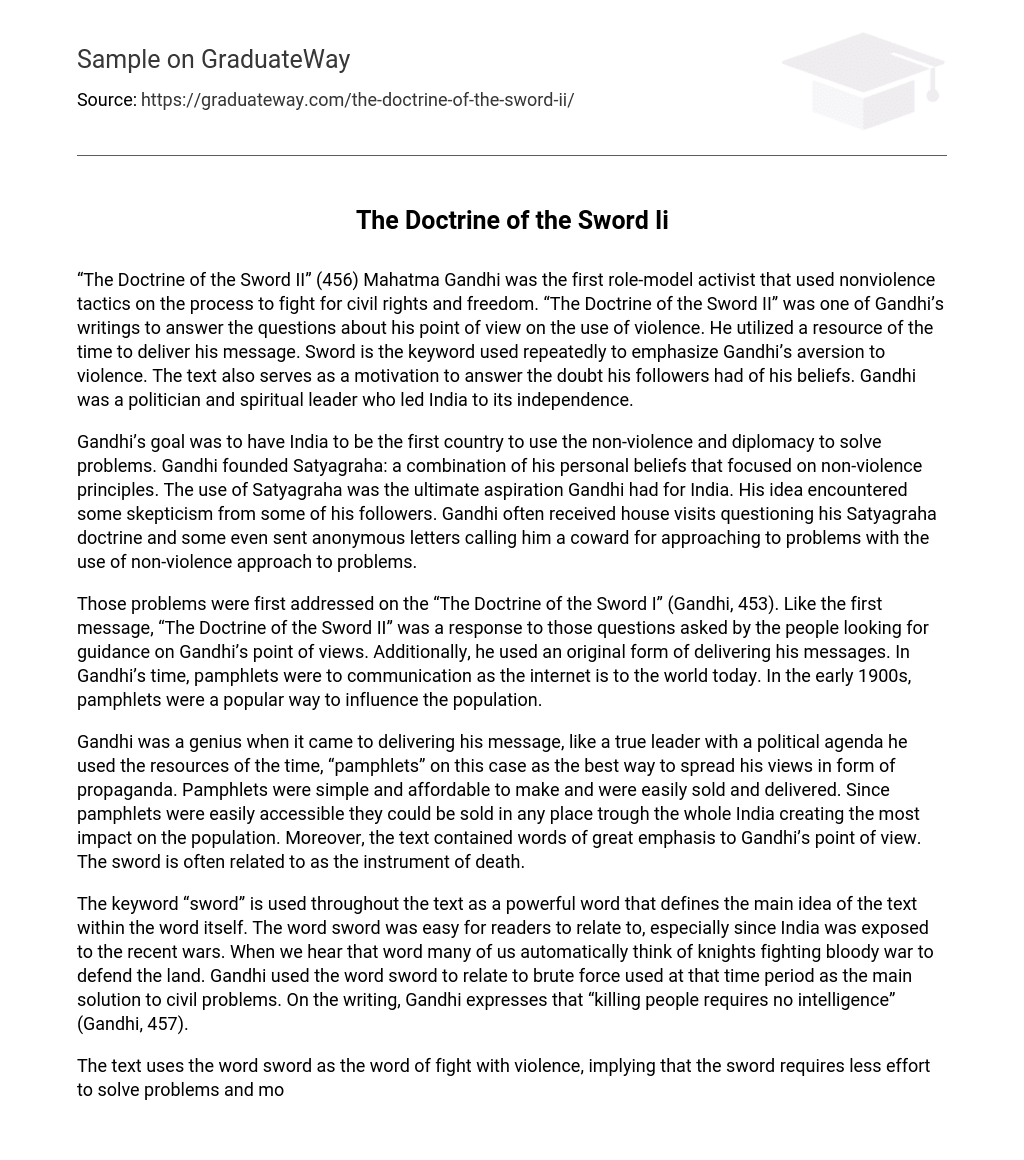“The Doctrine of the Sword II” (456) Mahatma Gandhi was the first role-model activist that used nonviolence tactics on the process to fight for civil rights and freedom. “The Doctrine of the Sword II” was one of Gandhi’s writings to answer the questions about his point of view on the use of violence. He utilized a resource of the time to deliver his message. Sword is the keyword used repeatedly to emphasize Gandhi’s aversion to violence. The text also serves as a motivation to answer the doubt his followers had of his beliefs. Gandhi was a politician and spiritual leader who led India to its independence.
Gandhi’s goal was to have India to be the first country to use the non-violence and diplomacy to solve problems. Gandhi founded Satyagraha: a combination of his personal beliefs that focused on non-violence principles. The use of Satyagraha was the ultimate aspiration Gandhi had for India. His idea encountered some skepticism from some of his followers. Gandhi often received house visits questioning his Satyagraha doctrine and some even sent anonymous letters calling him a coward for approaching to problems with the use of non-violence approach to problems.
Those problems were first addressed on the “The Doctrine of the Sword I” (Gandhi, 453). Like the first message, “The Doctrine of the Sword II” was a response to those questions asked by the people looking for guidance on Gandhi’s point of views. Additionally, he used an original form of delivering his messages. In Gandhi’s time, pamphlets were to communication as the internet is to the world today. In the early 1900s, pamphlets were a popular way to influence the population.
Gandhi was a genius when it came to delivering his message, like a true leader with a political agenda he used the resources of the time, “pamphlets” on this case as the best way to spread his views in form of propaganda. Pamphlets were simple and affordable to make and were easily sold and delivered. Since pamphlets were easily accessible they could be sold in any place trough the whole India creating the most impact on the population. Moreover, the text contained words of great emphasis to Gandhi’s point of view. The sword is often related to as the instrument of death.
The keyword “sword” is used throughout the text as a powerful word that defines the main idea of the text within the word itself. The word sword was easy for readers to relate to, especially since India was exposed to the recent wars. When we hear that word many of us automatically think of knights fighting bloody war to defend the land. Gandhi used the word sword to relate to brute force used at that time period as the main solution to civil problems. On the writing, Gandhi expresses that “killing people requires no intelligence” (Gandhi, 457).
The text uses the word sword as the word of fight with violence, implying that the sword requires less effort to solve problems and more physical suffering. Gandhi’s meaning of the word serves to persuade readers with the idea of degradation towards violence as a first approach to solving problems. For this purpose, the meaning of the text was to answer the doubts of his followers. India went through three different violent confrontations between late 1800s to early 1900s, thus, making violence a common form of problem solving. When Gandhi came up with the Satyagraha idea, he created a different way of thinking.
Many of India’s citizens were hesitant to nonviolence as a problem solver. Many confronted him personally or by writing. Some even made life threatening attempts as written on his text, “A Pathan made a murderous attack on me in 1908” (Gandhi, 457). Throughout history all leader go trough those types of confrontations with their followers and peers, but despite the pressure maintaining their goals and ideas is what makes then leader and not followers. Furthermore, the outcome of those threats led to a response in writing by Gandhi.
Gandhi wrote “The Doctrine of the Sword II” (456) for those who questioned his integrity and accused him of “shrewd fellow and so cunning” (Gandhi, 456) with the intention of calling him a liar for not letting them know his true beliefs on violence. These types of accusations made a group of Gandhi’s followers skeptical of his teaching about non-violence, especially on a world that was led by violent behavior. The text was to give Gandhi’s followers the reassurance of his point of view which still remained the same and cleared any misunderstanding.
The text is Gandhi’s way to use violence to answer the received letters for not believing in the physical violence doctrine. The text clears any questions on the use of violence, which sometimes is inevitable and should be only used when necessary, as explained on the reading, “We may, indeed, by misdirecting our intelligence employ it in the service of brute force but, though aided by intelligence, brute force remains brute force and the law of the sword remains the law of the beast. (Gandhi, 457). This form of repose is indeed great way to keep the people on your side of the fence and so effective that is still used today. Without reservations, the text delivers the intent to the audience. Gandhi uses “The Doctrine of the Sword II” to focus on the bigger picture for the Indian citizens. Similar questions were previously asked by his followers making this a significant matter to be addressed.
By addressing such issues, he regained credibility of his followers and further asked for their cooperation to achieve a nonviolent nation. The purpose of his writing was to reassure the faith of the Indian people and clear any doubts they had of Gandhi’s ultimate goal- having India as world model for peace by using nonviolence. Works Cited Gandhi, Mahatma. “The Doctrine of the Sword II. ” Cultural Conversations. Ed. Dilks, Hansen, Parfitt. Bedford/St Martin’s, 2001. 456-459.





